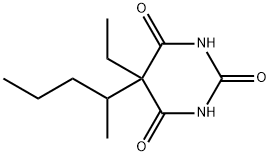
Pentobarbital
Bezeichnung:Pentobarbital
CAS-Nr76-74-4
Englisch Name:Pentobarbital
CBNumberCB5402863
SummenformelC11H18N2O3
Molgewicht226.27
MOL-Datei76-74-4.mol
Synonyma
Pentobarbital
Pentobarbital physikalisch-chemischer Eigenschaften
| Schmelzpunkt | 129.5°C |
| Siedepunkt | 367.89°C (rough estimate) |
| Dichte | 1.1376 (rough estimate) |
| Brechungsindex | 1.4620 (estimate) |
| Flammpunkt | 9℃ |
| storage temp. | 2-8°C |
| Löslichkeit | Very slightly soluble in water, freely soluble in ethanol. It forms water-soluble compounds with alkali hydroxides and carbonates and with ammonia. |
| Aggregatzustand | A neat solid |
| pka | pK1:8.11(0) (25°C) |
| Wasserlöslichkeit | 679 mg/L |
| CAS Datenbank | 76-74-4(CAS DataBase Reference) |
| NIST chemische Informationen | Pentobarbital(76-74-4) |
| EPA chemische Informationen | Pentobarbital (76-74-4) |
| Kennzeichnung gefährlicher | T,F |
| R-Sätze: | 25-63-39/23/24/25-36/38-23/24/25-11 |
| S-Sätze: | 7-16-36/37-45-36/37/39-22 |
| RIDADR | UN 2811 6.1/PG 3 |
| WGK Germany | 3 |
| RTECS-Nr. | CQ5775000 |
| HazardClass | 6.1(b) |
| PackingGroup | III |
| HS Code | 2933530000 |
| Giftige Stoffe Daten | 76-74-4(Hazardous Substances Data) |
| Toxizität | A barbiturate that causes CNS depression, apparently due to a facilitation of GABA-ergic inhibition. It appears that the site of action of pentobarbital may be the macromolecular complex made up of a GABA receptor, chloride channel, benzodiazepine-binding site, and picrotoxin-binding site. Barbiturates have been shown to compete for dihydropicrotoxinin-binding sites. In clinical use, barbiturates such as pentobarbital have been largely replaced as sedative-hypnotics by the much safer benzodiazepines. The sedative-hypnotic properties of barbiturates may lead to abuse, as tolerance and dependence are known to occur. In animals, pentobarbital is routinely used for its anesthetic and anticonvulsant properties, as well as for euthanasia. Pentobarbital, like other barbiturates, can induce the metabolism of other compounds by altering cytochrome P450 activity. The oral LD50 in rats is 118 mg/kg. |


